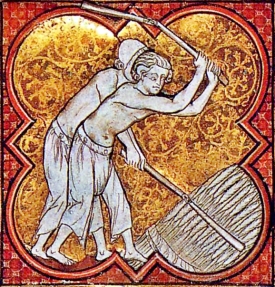01 A: Population change and food supply
Eras of population change
- Migration periods (300-600, 800-950)
- 1000-1300: growth
- 14th c: demographic crisis
Agricultural economy
Manor: Curtis
Kingston Lacy, Dorset ca 1370
Lord
Peasants (free or unfree)
Demesne
Crop rotation: 2 or 3 field systems
Points of change up to 1300:
- Population increase
- Regionally: urban growth means growth of food markets
- Clearing of land
- Sheep: urban wool trade
Crises of fourteenth century:
- “Little Ice Age”
- Famine years: Esp 1315-18 New book P. Slavin (Brepols)
- Cattle disease
- 1347-48 Black Death
After the Black Death: several stages
- Immediate: dislocation
- Intermediate term: more food per capita, prices decline
- Labor shortage: costs increase
- Marginal lands removed from production
- peasant revolts in 1380s
- Population continues to decline until ca 1400; long recovery
- Shift to lower labor products: sheep
- Commodity agriculture
- More meat in diet
Regional trends:
England:sheep, livestock; barley for beer and for livestock
France, Germany, Italy, Spain: wine
Germany: flax

Southern Europe: sugar, silkworms
Renting out of demesne lands at fixed rents to avoid dealing with labor problems
- More market economy in peasantry, increased size of peasant holdings
- Decrease in hereditary nature of peasant id. with plots of land
- Nobles less need to move around; fewer, fancier residences
- Enclosures; end of commons privileges
Southern Europe
- Mezzadria
- Transhumance
- Greater diversity of diet
- Urban governments and control of countryside
 |
 |
An urban granary: Florence, Orsanmichele



